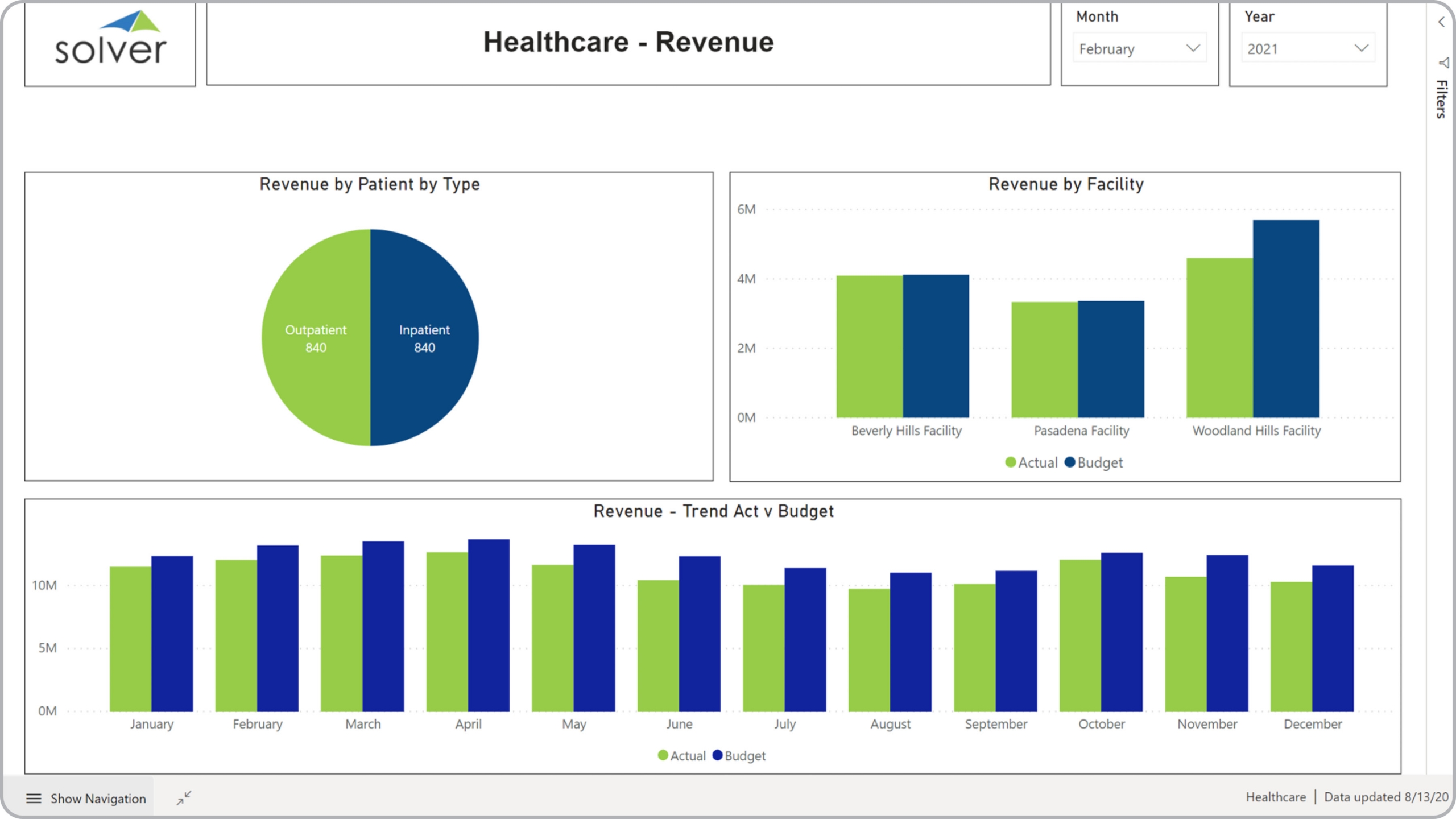Related Posts
- Subscription Billing Auto Forecast for SaaS Companies using Dynamics 365 Business Central
- Top 50 Opportunities Report for SaaS Companies using Dynamics 365 BC
- Subscription Sales by Contract Length Report for SaaS Companies using Dynamics 365 Business Central
- Multi-Year Profit & Loss Forecast Model for SaaS Companies using Dynamics 365 Business Central
- Lead Target Model for SaaS Companies using Dynamics 365 Business Central
Revenue Dashboard for Healthcare Providers
 Purpose of
Revenue Dashboards for Healthcare Providers Healthcare organizations use Revenue Dashboards to analyze trends and comparisons of income by patient type and from different facilities. When used as part of good business practices in a Financial Planning & Analysis (FP&A) department, an organization can improve its revenue generating strategies, and it can reduce the chances that important trends are missed with resulting impact on margins and surplus/deficit.
Example of a
Revenue Dashboard for a Healthcare Provider Here is an example of a Revenue Dashboard for healthcare providers with trends and budget comparison. [caption id="" align="alignnone" width="2560"]
Purpose of
Revenue Dashboards for Healthcare Providers Healthcare organizations use Revenue Dashboards to analyze trends and comparisons of income by patient type and from different facilities. When used as part of good business practices in a Financial Planning & Analysis (FP&A) department, an organization can improve its revenue generating strategies, and it can reduce the chances that important trends are missed with resulting impact on margins and surplus/deficit.
Example of a
Revenue Dashboard for a Healthcare Provider Here is an example of a Revenue Dashboard for healthcare providers with trends and budget comparison. [caption id="" align="alignnone" width="2560"]
 Example of a Revenue Dashboard for Healthcare Providers[/caption] You can find hundreds of additional examples
here
Who Uses This Type of
Dashboard
? The typical users of this type of dashboard are: Executives, CFOs, analysts.
Other Reports Often Used in Conjunction with
Revenue Dashboards Progressive Financial Planning & Analysis (FP&A) departments sometimes use several different Revenue Dashboards, along with profit & loss reports, balance sheets, cash flow statements, annual budgets and forecasts, billing dashboards, detailed revenue reports and other management and control tools.
Example of a Revenue Dashboard for Healthcare Providers[/caption] You can find hundreds of additional examples
here
Who Uses This Type of
Dashboard
? The typical users of this type of dashboard are: Executives, CFOs, analysts.
Other Reports Often Used in Conjunction with
Revenue Dashboards Progressive Financial Planning & Analysis (FP&A) departments sometimes use several different Revenue Dashboards, along with profit & loss reports, balance sheets, cash flow statements, annual budgets and forecasts, billing dashboards, detailed revenue reports and other management and control tools.
 Where Does the Data for Analysis Originate From? The Actual (historical transactions) data typically comes from enterprise resource planning (ERP) systems like: Microsoft Dynamics 365 (D365) Finance, Microsoft Dynamics 365 Business Central (D365 BC), Microsoft Dynamics AX, Microsoft Dynamics NAV, Microsoft Dynamics GP, Microsoft Dynamics SL, Sage Intacct, Sage 100, Sage 300, Sage 500, Sage X3, SAP Business One, SAP ByDesign, Acumatica, Netsuite and others. In analyses where budgets or forecasts are used, the planning data most often originates from in-house Excel spreadsheet models or from professional corporate performance management (CPM/EPM) solutions.
What Tools are Typically used for Reporting, Planning and Dashboards? Examples of business software used with the data and ERPs mentioned above are:
Where Does the Data for Analysis Originate From? The Actual (historical transactions) data typically comes from enterprise resource planning (ERP) systems like: Microsoft Dynamics 365 (D365) Finance, Microsoft Dynamics 365 Business Central (D365 BC), Microsoft Dynamics AX, Microsoft Dynamics NAV, Microsoft Dynamics GP, Microsoft Dynamics SL, Sage Intacct, Sage 100, Sage 300, Sage 500, Sage X3, SAP Business One, SAP ByDesign, Acumatica, Netsuite and others. In analyses where budgets or forecasts are used, the planning data most often originates from in-house Excel spreadsheet models or from professional corporate performance management (CPM/EPM) solutions.
What Tools are Typically used for Reporting, Planning and Dashboards? Examples of business software used with the data and ERPs mentioned above are:
- Native ERP report writers and query tools
- Spreadsheets (for example Microsoft Excel)
- Corporate Performance Management (CPM) tools (for example Solver)
- Dashboards (for example Microsoft Power BI and Tableau)
 Corporate Performance Management (CPM) Cloud Solutions and More Examples
Corporate Performance Management (CPM) Cloud Solutions and More Examples
- View 100’s of reporting, consolidations, planning, budgeting, forecasting and dashboard examples here
- View a Healthcare white paper and other industry-specific information here
- See how reports are designed in a modern report writer using a cloud-connected Excel add-in writer
- Discover how the Solver CPM solution delivers financial and operational reporting
- Discover how the Solver CPM solution delivers planning, budgeting and forecasting
- Watch demo videos of reporting, planning and dashboards
TAGS: Reporting, Planning, Forecasting, Analysis, Budgeting, CPM, KPIs, ERP, Dashboards, Industry, Financial Reporting, Template Library
Global Headquarters
Solver, Inc.
Phone: +1 (310) 691-5300
